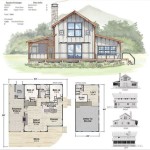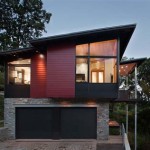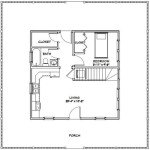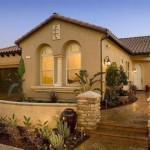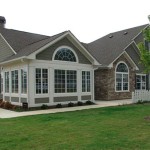Waterfront house plans are architectural designs specifically tailored to homes built on or near bodies of water such as oceans, lakes, or rivers. These plans encompass all aspects of the home’s design, including the layout, exterior features, and interior spaces, with an emphasis on maximizing the home’s relationship with the waterfront.
Waterfront house plans often incorporate unique design elements, such as large windows and decks, that take advantage of the natural beauty of the surrounding water. They may also include features such as boat docks, boat lifts, and outdoor living areas that enhance the waterfront lifestyle. One notable example is the “Seascape House” plan, designed by architect Peter Rose, which features a dramatic curved roofline and expansive glass walls that provide panoramic views of the ocean.
In the following sections, we will explore the various aspects of waterfront house plans, including design considerations, architectural styles, and factors to consider when choosing a plan. We will also provide tips and resources to help guide you in selecting the perfect waterfront house plan for your dream home.
When designing a waterfront home, there are several important points to consider:
- Flood zones
- Water access
- Views
- Sun orientation
- Outdoor living spaces
- Architectural style
- Sustainability
- Zoning restrictions
By carefully considering these factors, you can create a waterfront home that is both beautiful and functional.
Flood zones
Flood zones are areas that have been identified as having a high risk of flooding. These zones are typically determined by the Federal Emergency Management Agency (FEMA) and are based on historical flood data, rainfall data, and other factors. When choosing a waterfront house plan, it is important to consider the flood zone in which the property is located.
There are three main types of flood zones:
- High-risk flood zones are areas that have a 1% or greater chance of flooding in any given year. These zones are typically located in areas that are directly adjacent to bodies of water, such as rivers, lakes, and oceans.
- Moderate-risk flood zones are areas that have a 0.2% to 1% chance of flooding in any given year. These zones are typically located in areas that are not directly adjacent to bodies of water, but that are still at risk of flooding due to factors such as heavy rainfall or snowmelt.
- Low-risk flood zones are areas that have a less than 0.2% chance of flooding in any given year. These zones are typically located in areas that are not at risk of flooding, or that are protected by flood control measures such as levees or dams.
If you are considering building a waterfront home in a high-risk flood zone, it is important to take steps to protect your home from flooding. These steps may include elevating the home on pilings or stilts, installing flood vents, and purchasing flood insurance.
Even if you are not in a high-risk flood zone, it is still important to be aware of the potential for flooding. Heavy rainfall or snowmelt can cause flooding in areas that are not typically at risk. If you are concerned about the risk of flooding, you should consider purchasing flood insurance.
Water access
Water access is an important consideration when choosing a waterfront house plan. The type of water access you have will determine the activities you can enjoy and the type of boat you can own.
- Direct water access means that your property has a dock or pier that allows you to launch your boat directly into the water. This is the most desirable type of water access, as it gives you the most freedom and flexibility.
- Indirect water access means that you have to cross someone else’s property to get to the water. This is less desirable than direct water access, but it can still be a good option if you don’t mind the inconvenience.
- Limited water access means that you have to launch your boat from a public boat ramp or marina. This is the least desirable type of water access, but it can still be a good option if you don’t own a boat or if you only use your boat occasionally.
- No water access means that your property does not have any access to the water. This is not ideal if you want to enjoy waterfront activities, but it can still be a good option if you are looking for a quiet and secluded property.
In addition to the type of water access, you should also consider the depth of the water and the width of the channel. If you have a large boat, you will need to make sure that the water is deep enough and the channel is wide enough to accommodate your boat.
Views
The views from your waterfront home are one of the most important factors to consider when choosing a house plan. A well-designed plan will maximize the views of the water and surrounding landscape, while also providing privacy and shelter from the elements.
There are several factors to consider when evaluating the views from a waterfront home plan:
- Orientation of the house: The orientation of the house will determine which direction the views will face. In the northern hemisphere, homes that face south will have the best views of the water and the most sunlight. In the southern hemisphere, homes that face north will have the best views.
- Elevation of the house: The elevation of the house will also affect the views. Homes that are built on higher ground will have better views than homes that are built on lower ground. If your property is on a slope, you may want to consider building a home with a walk-out basement or a second story to take advantage of the views.
- Size and placement of windows: The size and placement of windows will also affect the views. Large windows will provide more views of the water, while smaller windows will provide more privacy. You should also consider the placement of windows in relation to the sun. Windows that face south will let in the most sunlight, while windows that face north will provide more shade.
- Outdoor living spaces: Outdoor living spaces, such as decks and patios, can also be used to maximize the views. When designing your outdoor living spaces, be sure to consider the orientation of the house, the elevation of the property, and the size and placement of windows.
By carefully considering all of these factors, you can choose a waterfront house plan that will provide you with the best possible views of the water and surrounding landscape.
In addition to the factors listed above, you should also consider the following when evaluating the views from a waterfront home plan:
- The presence of trees and other vegetation: Trees and other vegetation can block views of the water. When choosing a house plan, be sure to consider the location of trees and other vegetation on your property.
- The presence of other buildings: Other buildings, such as and commercial buildings, can also block views of the water. When choosing a house plan, be sure to consider the location of other buildings in the area.
- The presence of power lines and other utilities: Power lines and other utilities can also block views of the water. When choosing a house plan, be sure to consider the location of power lines and other utilities in the area.
By carefully considering all of these factors, you can choose a waterfront house plan that will provide you with the best possible views of the water and surrounding landscape.
Sun orientation
Sun orientation is an important consideration when choosing a waterfront house plan. The orientation of your home will determine how much sunlight you receive, as well as the direction of the views from your windows. In the northern hemisphere, homes that face south will have the most sunlight and the best views of the water. In the southern hemisphere, homes that face north will have the most sunlight and the best views.
If you are planning to build a waterfront home, you should carefully consider the sun orientation of the property. If you want to maximize the amount of sunlight you receive, you should choose a property that faces south in the northern hemisphere or north in the southern hemisphere. You should also consider the location of trees and other vegetation on the property, as these can block sunlight. Additionally, you should consider the location of other buildings in the area, as these can also block sunlight.
Once you have considered the sun orientation of the property, you can start to choose a house plan. There are many different house plans available, so you should be able to find one that meets your needs and preferences. When choosing a house plan, be sure to consider the size and placement of windows. Large windows will let in more sunlight, while smaller windows will provide more privacy. You should also consider the placement of windows in relation to the sun. Windows that face south will let in the most sunlight, while windows that face north will provide more shade.
By carefully considering the sun orientation of the property and the size and placement of windows, you can choose a waterfront house plan that will provide you with the most sunlight and the best views of the water.
In addition to the factors listed above, you should also consider the following when evaluating the sun orientation of a waterfront house plan:
- The time of day you will be using the home: If you will be using the home primarily during the day, you will want to choose a plan that maximizes the amount of sunlight you receive. If you will be using the home primarily in the evening, you may want to choose a plan that provides more shade.
- The climate of the area: If you live in a warm climate, you may want to choose a plan that provides more shade. If you live in a cold climate, you may want to choose a plan that maximizes the amount of sunlight you receive.
By carefully considering all of these factors, you can choose a waterfront house plan that will meet your needs and preferences.
Outdoor living spaces
Outdoor living spaces are an essential part of any waterfront home. They allow you to enjoy the beautiful scenery, relax in the fresh air, and entertain guests. When choosing a waterfront house plan, be sure to consider the following outdoor living spaces:
- Decks: Decks are a great way to extend your living space outdoors. They can be used for dining, entertaining, or simply relaxing and enjoying the views. When designing your deck, be sure to consider the size, shape, and location. You should also consider the type of decking material you want to use.
- Patios: Patios are another popular outdoor living space. They are typically made of concrete, brick, or pavers. Patios are a great place to entertain guests or simply relax and enjoy the outdoors. When designing your patio, be sure to consider the size, shape, and location. You should also consider the type of patio material you want to use.
- Screened porches: Screened porches are a great way to enjoy the outdoors without having to worry about bugs. They are typically enclosed with screens and may have a ceiling fan or other amenities. Screened porches are a great place to relax and enjoy the views, or to entertain guests. When designing your screened porch, be sure to consider the size, shape, and location. You should also consider the type of screening material you want to use.
- Sunrooms: Sunrooms are a great way to enjoy the outdoors all year round. They are typically enclosed with glass windows and may have a heating and cooling system. Sunrooms are a great place to relax and enjoy the views, or to entertain guests. When designing your sunroom, be sure to consider the size, shape, and location. You should also consider the type of glass windows you want to use.
In addition to the outdoor living spaces listed above, you may also want to consider the following:
- Fire pits: Fire pits are a great way to extend your outdoor living space into the evening hours. They can be used for cooking, entertaining, or simply relaxing and enjoying the fire. When choosing a fire pit, be sure to consider the size, shape, and location. You should also consider the type of fuel you want to use.
- Outdoor kitchens: Outdoor kitchens are a great way to enjoy cooking and entertaining outdoors. They can be equipped with a variety of appliances, such as grills, refrigerators, and sinks. When designing your outdoor kitchen, be sure to consider the size, shape, and location. You should also consider the type of appliances you want to use.
- Swimming pools: Swimming pools are a great way to cool off on hot summer days. They can also be used for exercise and recreation. When choosing a swimming pool, be sure to consider the size, shape, and location. You should also consider the type of pool you want, such as an in-ground pool or an above-ground pool.
By carefully considering all of these factors, you can choose a waterfront house plan that will provide you with the perfect outdoor living space for your needs and preferences.
Architectural style
The architectural style of your waterfront home is a matter of personal preference. However, there are certain styles that are more common and more suited to waterfront living than others. Here is a list of some of the most popular architectural styles for waterfront homes:
- Coastal: Coastal style homes are designed to reflect the relaxed and casual lifestyle of coastal living. They typically feature open floor plans, large windows, and decks or patios that take advantage of the views. Coastal homes often incorporate natural materials such as wood, stone, and brick.
Coastal style homes with waterfront access are an excellent choice for those who want to enjoy the beauty and tranquility of waterfront living. They are also a good choice for those who want a home that is both stylish and comfortable.
- Contemporary: Contemporary style homes are characterized by their clean lines, simple forms, and use of glass and steel. They often feature open floor plans and large windows that take advantage of the views. Contemporary homes can be built with a variety of materials, but they often incorporate natural materials such as wood and stone.
Waterfront contemporary homes are a good choice for those who want a modern and stylish home that takes advantage of the views. They are also a good choice for those who want a home that is low-maintenance and easy to clean.
- Craftsman: Craftsman style homes are characterized by their use of natural materials, such as wood and stone, and their attention to detail. They often feature exposed beams, built-in cabinetry, and large windows. Craftsman homes are typically cozy and inviting, and they make a great choice for waterfront living.
Waterfront craftsman homes are a good choice for those who want a home that is both stylish and comfortable. They are also a good choice for those who want a home that is built to last.
- Mediterranean: Mediterranean style homes are characterized by their whitewashed walls, red tile roofs, and arched windows and doorways. They often feature courtyards or patios, and they are typically surrounded by lush landscaping. Mediterranean homes are known for their beauty and their ability to create a sense of place.
Waterfront Mediterranean homes are a good choice for those who want a home that is both stylish and exotic. They are also a good choice for those who want a home that is perfect for entertaining.
In addition to the architectural styles listed above, there are many other styles that can be used for waterfront homes. When choosing a style, it is important to consider your personal preferences, the climate of the area, and the views from the property.
Sustainability
Sustainability is an important consideration when choosing a waterfront house plan. Sustainable homes are designed to minimize their impact on the environment, and they can offer a number of benefits, including lower energy costs, reduced water consumption, and a healthier indoor environment.
There are many different ways to make a waterfront home more sustainable. Some of the most effective strategies include:
- Using sustainable building materials: Sustainable building materials are materials that are produced in a way that minimizes their environmental impact. These materials include recycled materials, renewable materials, and materials that are produced locally. Using sustainable building materials can help to reduce the carbon footprint of your home and support sustainable businesses.
- Installing energy-efficient appliances and systems: Energy-efficient appliances and systems use less energy to operate, which can save you money on your energy bills and reduce your carbon footprint. When choosing appliances and systems for your waterfront home, be sure to look for the ENERGY STAR label. ENERGY STAR appliances and systems meet strict energy efficiency standards, and they can help you to save money on your energy bills.
- Using renewable energy sources: Renewable energy sources, such as solar and wind power, can help you to reduce your reliance on fossil fuels and reduce your carbon footprint. If you are interested in using renewable energy to power your waterfront home, be sure to research the available options and choose a system that is right for your needs.
- Conserving water: Conserving water is important for both environmental and economic reasons. There are many ways to conserve water in your waterfront home, such as installing low-flow fixtures, watering your lawn less frequently, and collecting rainwater for irrigation. By conserving water, you can help to protect the environment and save money on your water bills.
By incorporating sustainable features into your waterfront house plan, you can create a home that is both beautiful and environmentally friendly. Sustainable homes are a wise investment for the future, and they can help you to save money on your energy and water bills.
In addition to the environmental benefits, sustainable waterfront homes can also offer a number of health benefits. Sustainable homes are typically built with healthier materials, and they often have better indoor air quality than conventional homes. This can lead to a number of health benefits, including reduced respiratory problems, allergies, and asthma.
Zoning restrictions
Zoning restrictions are regulations that govern the use of land and buildings in a specific area. These restrictions are typically enacted by local governments to ensure that land is used in a way that is compatible with the surrounding community. Zoning restrictions can affect a wide range of factors, including the size and height of buildings, the types of businesses that can operate in an area, and the amount of parking that must be provided.
When it comes to waterfront house plans, zoning restrictions can play a significant role in determining what is and is not allowed. Here are some of the most common zoning restrictions that can affect waterfront house plans:
- Setbacks: Setbacks are the minimum distances that must be maintained between buildings and property lines. Setbacks are typically required to ensure that buildings do not encroach on public rights-of-way or properties. Setbacks can also be used to protect sensitive environmental areas, such as wetlands or beaches.
- Height limits: Height limits restrict the height of buildings in a specific area. Height limits are typically used to ensure that buildings do not block sunlight or views from neighboring properties. Height limits can also be used to protect the character of a historic district or to prevent buildings from becoming too tall and unwieldy.
- Density restrictions: Density restrictions limit the number of units that can be built on a specific piece of land. Density restrictions are typically used to prevent overcrowding and to ensure that there are adequate public services, such as schools and roads, to support the population.
- Use restrictions: Use restrictions limit the types of uses that are allowed in a specific area. Use restrictions can be used to segregate incompatible uses, such as industrial uses from residential uses. Use restrictions can also be used to protect certain areas, such as historic districts or habitats.
It is important to be aware of the zoning restrictions that apply to your property before you start designing your waterfront house plan. Zoning restrictions can vary significantly from one jurisdiction to another, so it is important to check with your local planning department to find out what restrictions apply to your property.










Related Posts

